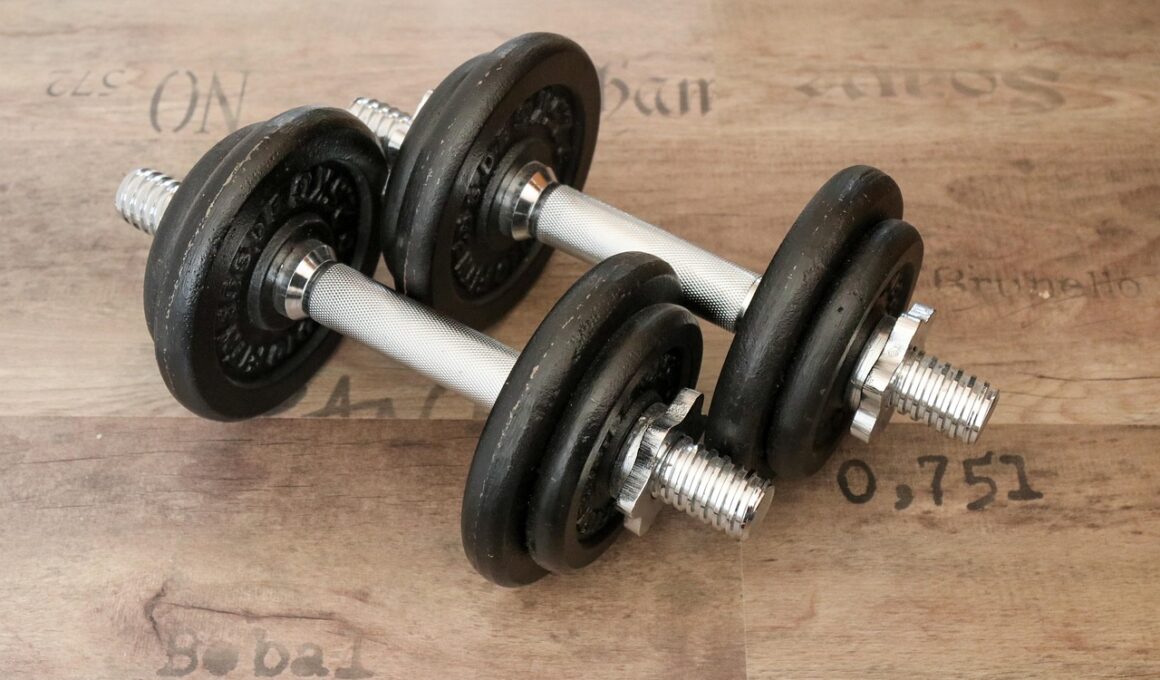Importance of Warm-Up and Cool-Down in Dumbbell Training
Warm-up exercises are a crucial component of any effective workout routine, especially when performing dumbbell exercises. They prepare the body for the intensity of training by gradually increasing heart rate and blood circulation. Engaging in a proper warm-up helps to enhance muscle elasticity and range of motion, which can prevent injuries. A dynamic warm-up, such as arm swings, leg swings, or bodyweight squats, specifically targeting the muscles to be worked with dumbbells is effective. This also improves focus and mental readiness, creating a positive mindset for the workout ahead. Furthermore, when the body is properly warmed up, the connectivity between the nervous system and muscles improves, leading to better muscle engagement during strength training. Ignoring this vital step can result in inadequate muscle activation and a higher risk of strains or sprains. According to fitness experts, a warm-up should last about 5 to 10 minutes, maintaining moderate intensity. This can significantly enhance performance in your dumbbell workouts, giving you the edge needed to achieve your fitness goals. Always prioritize warming up to enjoy safer and more productive exercise sessions.
Following the intensity of a workout with a cool-down is as important as the warm-up phase, particularly after engaging in dumbbell exercises. Cool-downs gradually decrease the heart rate and help transition the body back to its resting state. This is vital because a sudden stop in activity may lead to dizziness or lightheadedness due to blood pooling in the extremities. By incorporating cooldown exercises like static stretches focusing on the major muscle groups worked, you can enhance flexibility and reduce muscle soreness. These stretches should be held for approximately 15 to 30 seconds to maximize their benefits. Additionally, cooldowns provide an excellent opportunity to reflect on the workout and evaluate performance, setting the stage for progress in future sessions. Incorporating deep breathing during the cooldown phase can also promote relaxation and facilitate recovery, which is essential for muscle repair and growth. Many fitness enthusiasts overlook this aspect, contributing to delayed onset muscle soreness (DOMS) following dumbbell workouts. Therefore, never skip the cooldown; it is essential for optimal recovery and overall fitness well-being.
Benefits of An Effective Warm-Up
Aside from injury prevention, there are numerous benefits associated with an effective warm-up routine. A proper warm-up not only physically prepares the body but also mentally primes you for the workout session. It enhances focus, which is crucial for achieving optimal results during resistance training, including dumbbell workouts. When the body’s temperatures increase, metabolic processes accelerate, leading to improved energy availability and quicker muscle reaction times. This ultimately allows you to lift weights more effectively than when you’re cold. Furthermore, warming up can improve strength and endurance, as muscles can contract more efficiently with increased temperature. Some studies suggest that regular warm-ups may also improve overall performance metrics like strength, power, and endurance over time. Additionally, warming up regularly helps your body adapt better to varying exercise intensities and volumes, making your training more effective and allowing for progressive overload safely. Therefore, it stands out as a non-negotiable aspect of any comprehensive workout regimen, ensuring your body is ready to tackle the challenges ahead.
In the context of dumbbell workouts, specific warm-up exercises targeting the upper and lower body are particularly beneficial. Dynamic stretches and movements like shoulder circles, arm rotations, and hip openers are ideal for preparing for intensive lifting. For instance, perform some dumbbell curls with lighter weights as part of your warm-up to prepare the biceps for heavier lifting. Moreover, these warm-up activities help to engage the core, which plays a key role in stabilizing movements during dumbbell training. Activating the core before a workout can significantly enhance balance and control, allowing for more effective weightlifting techniques. Adapting your warm-up to the specific dumbbell exercises you plan to perform maximizes its benefits, ensuring that the correct muscles are prepped for the load. Furthermore, the time spent on warm-ups can actually be seen as an investment rather than a loss of time. With enhanced performance, you’ll be able to complete your workouts more efficiently, saving time in the long run while achieving better results. In conclusion, targeting specific areas in your warm-up routine is essential for optimizing your dumbbell workout effectiveness.
Understanding The Cool-Down Process
An effective cool-down routine consists of various methods aimed at easing the transition from exertion to rest. Techniques like static stretching and controlled breathing help lower heart rates while improving flexibility. Focus on stretches for the muscles that were predominantly used during the dumbbell exercises. These stretches not only relieve muscle tightness but also promote blood flow to any newly engaged muscle fibers. Exercises such as tricep stretches, chest openings, and quadricep stretches should be included to enhance recovery. Consider integrating foam rolling as part of your cooldown routine to further alleviate muscle soreness. It aids in myofascial release, helping to release muscle tension and tightness accumulated during the workout. A cooldown is not merely about ending the workout; it is the body’s way of adapting back to a resting state. The recovery achieved through cooldowns can significantly improve your next workout session’s efficiency. Establishing a consistent cooldown routine can effectively reduce your post-workout soreness, which is instrumental in maintaining a regular workout schedule without undue pain or discomfort.
Combining the warm-up and cool-down creates a rounded approach to managing your workout, reinforcing smooth transitions between phases of your exercise. This holistic treatment ensures maximum efficiency and effectiveness. Both phases not only prepare and recover the body physically but also mentally associate a sense of completion with any exercise session. Importantly, failing to warm up and cool down might not present immediate consequences but can lead to chronic injuries over time. As a long-term strategy for fitness enthusiasts, it is crucial to appreciate the role of these phases in your overall regimen. Consider setting specific goals for incorporating these practices into your routine to ensure they don’t become neglected. By doing so, you can cultivate a more disciplined approach and strengthen your overall workout routine. It can also contribute to more enjoyable and engaging sessions, as the body learns to anticipate the structure of warm-ups and cooldowns. Engaging in this disciplined approach makes you more attuned to your body’s signals, encouraging self-correction and adaptability in your exercise strategy.
Conclusion: The Lasting Impact of Warm-Up and Cool-Down
In conclusion, the importance of warm-up and cool-down phases cannot be overstated. They are integral parts of a comprehensive dumbbell training regimen. Their roles in enhancing performance, reducing injury risks, and facilitating recovery are paramount. A strong commitment to these segments of your workout enhances overall fitness quality and ensures longevity in your training pursuits. Regularly incorporating effective warm-up exercises has admirable short-term and long-term benefits. Similarly, the cooldown process establishes a foundation for recovery, which is essential for muscle growth and performance improvements. As you continue to engage in dumbbell workouts, always remember that taking time for these phases is not wasted time but an investment in your health. Over time, the results from prioritizing warm-ups and cooldowns will be evident in your training outcomes. Commit to this routine, and experience how it fundamentally changes your approach to fitness. In the end, the reward is not only better workout efficiency but also a more enjoyable exercise experience overall. Your body will thank you in the form of increased strength, flexibility, and much more as you stay consistent with these foundational practices.
As your journey in fitness progresses, always keep the warm-up and cool-down as an integral part of your training. They provide significant benefits and ensure that the body remains healthy and resilient. Therefore, commit to enhancing your workouts with these fundamental elements, which not only improve performance but also enhance your enjoyment of dumbbell training. Making warm-ups and cool-downs a routine part of your training will lead to more effective and satisfying workout sessions.


